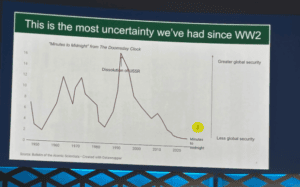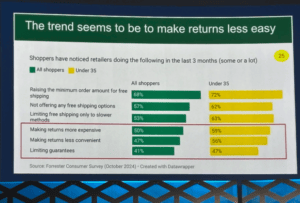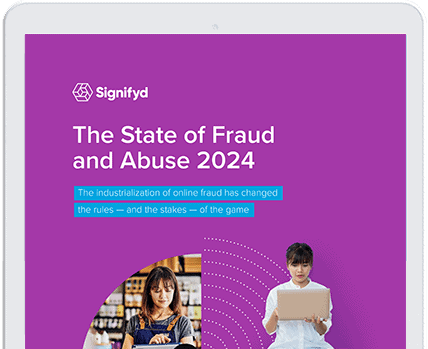So you’re looking for key takeaways from Signifyd’s FLOW Summit 2025. Here’s one: The future of retail is bright.
That’s right. Despite tariffs and their fallout, economic uncertainty and concerns about inflation, the nearly 300 retail industry professionals gathered in lower Manhattan last week heard about a new era of intelligent retail returns, how to navigate tariffs, how fraud and risk teams are evolving into strategy centers, how AI continues a warp-speed digital transformation — and how silos are out, data scientist are in and why retail is still one of the most innovative industries in the world.
“In this conference today, you’ll hear lots of inspiring stories. You’re going to hear innovative solutions. You’re going to see that booth where people are going to walk through different products and you’re going to hear fresh ideas,” Signifyd CEO Raj Ramanad said, as he opened the Summit and welcomed attendees. “But remember, what truly lies in this world is the relationships we build together. We’re thriving because of this.”
“In this conference today, you'll hear lots of inspiring stories. You're going to hear innovative solutions. But remember, what truly lies in this world is the relationships we build together. We’re thriving because of this.”
Raj Ramanand, Signifyd co-founder and CEO
And so, in case you missed it, here’s a summary of those inspiring stories, innovative solutions and fresh ideas that can help you thrive. Oh and one more thing: On-demand videos of the sessions below will be available very soon. Stay tuned.
The future of returns is here
Signifyd CEO Raj Ramanand opened the FLOW Summit 2025 by announcing two products that give retailers deeper insights into and more control over one of the industry’s most pressing challenges: Returns.
He outlined the $890 billion industry-wide problem and how 26% of that represents an operational loss and how 20% of that represents abusive returns.
“If I’m getting $890 billion in returns, of which 45% of it could be avoided,” Ramanand said, referring to the abuse and operational cost, “if you could lower that down significantly, that’s a major savings that most retailers today just don’t have the ability to do because of the lack of insights.”
Instant refunds promote instant repurchases
And if retailers could also better manage legitimate returns and provide instant refunds to deserving customers, that opens additional sales. Signifyd’s early work with merchants shows that 23% of consumers who receive an instant refund, will almost instantly buy something again from that retailer.
“Now it seems like a small number,” Ramanand said. “But it’s a staggering number for a billion-dollar business — if you’ve got somewhere between a 15% to 20% return rate.”
And then he unveiled Return Insights and Instant Refunds, two products that enable merchants to save those dramatic costs and capture that additional revenue — all while providing their customers with a better experience both pre-purchase and post-purchase.
“When someone comes in to return something,” Ramanand said, “we believe the future gold standard for that experience is that if you are a good person, you should get your money back instantly,’’ he said.
The returns products are a natural evolution for Signifyd, Ramanand said, as he traced the company’s roots to Guaranteed Fraud Protection, followed by Guaranteed Abuse Protection. The returns products rely on the same insights from hundreds of millions of buyers that Signifyd sees through the thousands of merchants Signifyd serves. And that massive number of consumers is only growing, Ramanand said.
All of which means more good things ahead.
Silos are so 2021 — Cross-functional is the thing
You can’t afford to have silos in a data-driven world. Data is all about visibility — seeing what’s happening and what’s ahead. And if you’re not looking, you’re going to miss — big.
Ecommerce executives from Wayfair, Pandora and Lenovo spoke with Signifyd’s Chief Customer Officer J. Bennett about how they have broken up silos and moved into the future. Curtis Crawford of Wayfair pointed to the home goods retailer’s work to integrate online and in-store shopping for customers.
“We’re going to make you feel known and appreciated,” when you move online to in-store, Crawford, director and GM of fintech and loyalty said. It sounds simple, but it requires teams across functions to understand the goal and, maybe as important, to know why the goal exists.
Breaking down silos means building cross-functional visibility
It’s important for “cross-functional teams to have a good idea of what’s going on outside their neck of the woods,” he said.
Pandora’s Vice President of Ecommerce Elizabeth Garry reinforced the importance of “why.” A good leader should be a good storyteller.
It’s about “how you articulate the why,” she said. If you want to break down silos, you want your team to understand why strategies are changing or new approaches are underway. But you also want cross-functional teams to have the same deep insights — and goals.
Ah, goals. There was broad consensus from Crawford, Garry and Lenovo Vice President of Ecommerce Carlo Savino on that one. Everybody needs to be aware of the goals and it’s important for different teams across a retail organization to be working toward the same key performance indicators (KPI).
When everyone knows the why, the what, and how success is measured, silos crumble and disappear.
Finding the balance in ecommerce carries a high degree of difficulty
Cindy Turner, Worldpay’s chief product officer, knows how to make a case for finding cost savings in the checkout and payment processes.
First, there is the opportunity: Ecommerce is growing at 8% a year. Online sales are a growing portion of retail revenue and a powerful growth engine. But online merchants are faced with balancing managing fraud and risk, taming the rising costs of doing business, increasing conversion on their sites and meeting rising consumer expectations.
How does that look by the numbers? Turner put the annual cost of online fraud at $48 billion. Bad, but not as bad as the cost of false declines, or incorrectly turning away legitimate customers, which comes in at $443 billion. Add to that an average cart abandonment rate of 70% and you can see the challenge. And for good measure, consider that the cost to acquire those customers struggling through checkout increased by 222% since 2013, according to Turner.
Pre-auth creates a virtuous loop and increases authorization
So, what to do? The path to increased profitability starts with “pre-auth,” or screening orders for fraud before bank authorization. Moving to pre-authorization intensifies the risk assessment of each order by teaming the merchant (and any fraud-protection provider) with the issuer to conduct the risk assessment. It also creates a virtuous loop. By weeding out fraudulent orders before authorization, the banks see cleaner traffic. Over time that is rewarded by higher authorization rates.
Beyond preauth, merchants can optimize checkout by knowing their customers and paring down the need to manually fill out forms. Offering guest checkout increases convenience for those who don’t want to create accounts. Providing a range of payment options — including buy now, pay later — means customers are more likely to see their preferred payment method and therefore, more likely to buy. And making mobile checkout at least as easy as desktop means more conversions in a mobile world.
Finally, merchants should turn to AI to optimize their networks and minimize their costs in any number of ways, including by leaning into strategic payment routing.
In the race to increase customer lifetime value, AI is your friend
Lenovo’s Ajit Sivadasan is a firm believer in the power of AI to get a business where it needs to go. But don’t call him an AI fanboy.
In speaking with Signifyd CEO Raj Ramanand, Sivadasan, the president and global head of direct-to-consumer at Lenovo, cautioned against running after the AI hype and strongly advocated for a test-and-measure approach to deploying AI.
The real value from AI is to increase efficiency in areas that lend themselves to predictability — for instance, content, supply chain, forecasting, fraud prevention and personalization in Lenovo’s case. That’s how AI can be deployed to cut expenses in an era of rising costs that with inflation are reaching double-digit annual increases.
Humans plus machines are the winning combination
Sivadasan stressed his belief in the human-plus-machine approach of marrying smart machines with intelligent people to get the best outcomes.
When it comes to AI edge cases and Gen AI, it’s important for those humans to identify and avoid pitfalls, including the hallucinations that Gen AI sometimes experiences.
Sivadasan is probably a guy you want to listen to. He talked about impressive growth of 20% to 30% annually and how he helped Lenovo navigate a change from a heavily partnership-reliant business to a more direct focus on consumers.
Building a team that embraces that sort of change requires fostering a deep understanding of why change is necessary, Sivadasan said. As for the next steps, Sivadasan’s team is digging deeper into understanding consumers’ expectations while targeting small and medium businesses, the gaming community, students and creators as the brand works to draw new customers away from the pull of Apple products.
If you’re going to be obsessed, be obsessed with customers
Christine Rupp has made a career of understanding how digital experiences can connect consumers with a brand in deep and meaningful ways. The former Victoria’s Secret chief customer officer spoke with Emily Mikailli, Signifyd’s chief people officer and chief of staff to the CEO, about the good side of obsession — customer obsession.
Building that mindset into an organization starts with building the right team. Rupp, who serves on Canadian Tire’s board, lives by the rule that the best way to continuously improve is to hire people who are smarter than you. Whether you think of that in terms of intelligence or smarter in different things, being surrounded by people that are smarter than you allows a team to see things it otherwise wouldn’t.
Ecommerce is the retail growth engine
Also, remember that digital experience is where the growth is. It’s driving profit in ecommerce, as online sales become a bigger portion of retail sales every year.
Digital experiences, yes. But not just any digital experiences. In the end, noisy bells and loud whistles are just that — noisy and loud. Rupp told the assembled retail professionals that when building a customer experience, it’s important to identify the right moments — those places along the shopping journey where you can be helpful and not confusing.
How to nail returns without giving away the store
Panelists representing Rainbow Shops, HP and Wayfair combined to lay out the challenges that face online merchants in the post-COVID era during a panel discussion moderated by Signifyd Senior Director, Product Pedro Sanzovo. And there was room for optimism, too, given innovation in the area, including Signifyd’s announcement earlier in the day of Return Insights and Instant Refunds — two new returns solutions.
David Cost, vice president of ecommerce and digital at Rainbow Shops pointed out that Amazon’s liberal and convenient returns process has created high expectations among consumers who have become accustomed to receiving refunds right away. It’s something Amazon can do because of the insights it gains from the massive amount of consumer data it collects every minute of every day. The typical retailer — even one as large as Rainbow Shops — simply doesn’t have the volume of data necessary to confidently decide who is legitimately entitled to an instant refund.
Still, the retailer has worked to reduce abuse and add convenience for consumers by offering a ship-to-store option, which means shoppers can see and touch their items while in a store, if they choose. And ship-to-store means packages are held in a safe place not subject to porch piracy — an advantage that has helped reduce item-not-received claims by 80%.
Sayanti Debnath, HP.com Shopping’s head of product, said a strong returns program starts with clear returns policies. That way, shoppers know the rules of the game from the start. Encouraging customer reviews is a help, too. Knowing the experiences of others helps shoppers decide whether a product is for them, serving to limit returns overall.
And finally, personalization, of the kind offered by Instant Refunds, is a key to identifying upstanding customers in terms of returns and frees merchants to provide memorable returns experiences.
Work to quickly resolve the problems behind returns
Mariam Baig, Wayfair’s senior manager, scam prevention, suggested approaching returns with a tough but flexible returns policy. It’s best to assume good intentions on the part of a customer making a return. Live by the formula of underpromise and overdeliver and then go to work to quickly find a good resolution to a customer’s concern.
And to keep on top of fraudulent returns and surging trends cooperate with other teams. Baig’s team works closely with the warehouse team to stymie the current favorite — label manipulation and swapping the purchased item with an older, used version, for purposes of a return.
Yes, we need humans to fight fraud effectively
There was plenty of talk about AI — rightfully so — at the FLOW Summit. AI to fight fraud. AI to commit fraud. AI to lower costs. AI to increase efficiency.
But the need for intelligent humans to direct strategy, fine-tune models and add intuition to learning machines’ impressive decision-making was never far from the surface.
Nowhere was the topic more center stage than when Signfiyd’s Luz Cervantes led a panel of veteran industry experts through a real-world look at the power of humans plus machines.
Fraud and risk professionals are upgrading their skills in an AI world
The consensus? AI fraud protection models are constantly and quickly improving, which means the role of humans will change, but not go away. Fraud and risk professionals will need to ramp up their skills as artificial intelligence takes on more of the burden of protecting merchants from fraud while ensuring the maximum number of legitimate orders convert.
Pretty much one-by-one the panel of Chris Prest, Lego head of fraud prevention, Tracy Kobeda Brown, Merchant Risk Council vice president of programs and technology, Kenny Ramirez, Sonos manager of fulfillment operations and Tomasz Aniśko, Groupon director treasurer, fraud and payments, had a story about how fewer risk professionals are working on fraud teams in the AI-era, but that each one is doing more impactful work.
Aniśko allowed as to how fraud and risk professionals will continue to take an increasingly broader view of the customer journey.
“Teams are going to look at fraud more holistically on the checkout funnel, rather than just stopping fraud,” he said. “They’ll be more focused on strategy, refunds, chargebacks. “It’s coming already. Fraud is only a small start. So the fraud team will need to look at the whole picture and will be more involved in strategy on refunds, chargebacks, what’s involved in it.”
That will be made possible by the subject of an earlier presentation at FLOW 2025.
“Teams are going to no longer be siloed,” the MRC’s Brown said. “We’re going to be having the death of departments. Instead of managing teams, people are going to be managing models.”
Are “tariffs” and “uncertainty” synonyms? Yes — and no.

Yes, the topics of tariffs did come up at FLOW Summit 2025. But you knew that. There was no five-easy-steps-to-tackle-tariff advice. The truth is, it’s hard to know exactly where the tariff era is headed. And the challenges and possibilities in the face of tariffs can be wildly different for different merchants.
“The only thing I feel confident about is uncertainty,” said J. Bennett, Signifyd’s chief customer officer and the panel moderator.
Of course, that doesn’t mean there is nothing to be done. Panelists Indy Guha, a general partner at VMG Partners and Hani Batla, CIO and CTO at Adorama worked on presenting a framework to understand tariffs, which, of course, is an important step in dealing with them.
Retailers are modeling multiple scenarios to brace for tariffs
Building a strategy on tariffs starts with viewing operations, inventory, consumers — and pretty much everything — through the lens of tariffs. Proactive companies are building multiple models based on different scenarios to break through the fog and see into alternative futures. Growth predictions obviously vary, depending on the what-ifs.
For now, supply chain is an issue for many merchants. Chinese supply chains are facing pressures reminiscent of the late-COVID era. U.S. merchants are canceling orders and looking for alternatives. But shifting production locations is not easy and with uncertainty around tariffs, it’s hard to know where the safe harbors are.
Pricing, of course, is an issue. Start with the increased cost due to tariffs and the decision about how much of that to pass along to consumers. Merchants need to consider whether they are selling necessities, which generally can bear more upward pressure, or discretionary goods, which are more price-sensitive by definition. Consumers can do without them.
Possible alternatives are also a consideration for necessities and discretionary goods. Are there acceptable ways consumers can trade down? If so, it could be time to lean into reinforcing loyalty — to add services or experiences — that keep fans coming back.
“In times like these, I advise my customers to bring joy to their customers,” Bennett said.
Conversely, are you a merchant that offers a cheaper alternative. Rising prices might be an opportunity.
Added to the equation is the overall effect of price increases on consumers. Even a merchant selling goods not directly affected by tariffs will be affected by tariffs. Higher prices elsewhere leave consumers with less money to spend.
Consumers are pulling some spending forward
While it’s true shoppers spend less when inflation takes a bite, Adorama’s Batla noted that he’s currently seeing a boost in sales.
“People buy less when things get expensive, but in particular, what we are seeing is a bump in people buying because they are anticipating price increases,” he said.
Once again, technology and innovation might be part of the solution. AI-driven automation, for instance, can lower operating costs and show the way to optimal pricing and more efficient ways of doing business.
“There is a new class of thinking emerging on how do you build resilience into daily and weekly decision-making,” Guha said, “and what is the role of technology to support that?”
The kind of FLOW fraud presentation you don’t see every day
Vito is one of those celebrities who goes by just one name, um, Vito. He does have a last name, Petruzzelli, and a job as a Signifyd senior risk manager. But what he’s known for is the weekly Fraudcast.
We decided to take the show on the road and for the first time hold a live-and-in-person Fraudcast at FLOW Summit 2025.
Don’t feel bad if you missed it. Well, feel a little bad. As we mentioned, there will be an on-demand version. And even better, Vito will be hosting a live, virtual fraudcast every Wednesday at 2 p.m. EDT/ 11 a.m. PDT.
After years of disruptive events, retail in 2025 is having a year of disruptive events
If you ever wondered whether retail professionals had all that much to worry about, consider the presentation title that Forrester Vice President, Principal Analyst Sucharita Kodali offered at FLOW: “25 important issues affecting the chaotic landscape in 2025.”
Yeah. But knowledge is power, so understanding what’s out there is a good thing. And what’s out there starts with sagging consumer sentiment — comparable to historical lows, Kodali told the assembled crowd.

Forrester’s Kodali noted that consumers have a lot on their minds
Kodali explained that plenty is going on to dampen consumers’ enthusiasm. And there are aggravating circumstances — tariffs, supply chain issues. Cybercrime and a general distrust in institutions are also in the mix, changing the way consumers act.
Ecommerce sales are strong despite it all
But, you know what? Retail and ecommerce sales are healthy.
“Retail sales are still going up — even in spite of inflation,” Kodali said. “That’s the cognitive dissonance we continue to see.”
Consumers have been incredibly consistent through the years of disruptions and economic uncertainty. We’ll have to see whether the global trade war and the threat of rising inflation bring them to their breaking point.
“The only thing I feel confident about,” Kodali said, “is that we are in a period of tremendous uncertainty.”
And there are areas for retailers to explore and test. TikTok is creating significant change in the way shoppers buy — particularly Gen Z shoppers. Social commerce is a thing.
There is substantial room for improvement in the mobile channel. “Most companies haven’t revisited their mobile experience since 2010,” Kodali said.
Non-obvious areas for personalization present opportunities, she added. Stops along the buying journey, like checkout, identity verification requirements and returns policies come to mind.

In fact, Kodali noted that consumers have noticed that some retailers are beginning to tighten up their return policies by making returns more expensive and less convenient. Kodali’s prescription: Smart algorithms can help retailers provide the kinds of returns that build customer lifetime value.
So yes, retailers’ to-do list is long, but in the end, that is a good thing. Retailers have shown over the past half decade that their to-do lists become can-do lists and the year ahead is likely to be no different.
Retailers are their own saviors — technology is the tool they’ll use
It was only appropriate that Julie Wainwright closed the day of FLOW Summit sessions by getting real with the nearly 300 industry professionals in attendance.
Wainwright, the founder of resale luxury marketplace The RealReal echoed two key themes of the day. First, she emphasized the importance of investing in returning customers — building customer lifetime value to build the business. And she said AI would lead retail into the future — but not without intelligent humans taking the reins.
Find the AI that works for you
“Retail is a laggard business and it’s not going to serve you,” Wainwright said. “You need to embrace technology. You need to embrace AI. And you need to take care of returning customers first.”
AI is out there and it’s evolving by the day — the rise of Gen AI is a case in point. But, Wainwright said that retailers should not sit back and wait for the next big thing in AI to come along. Instead, they should work on finding ways to use AI creatively to reach their goals and better serve their customers.
Honoring the best in the business at a closing ceremony
After a day of teaching, learning and sharing, by late afternoon it was time to celebrate retail victories and those who are shaping the future of retail before our very eyes.
Signifyd Chief Customer Officer J. Bennett celebrated Signifyd’s 2025 class of the Most Influential in Ecommerce to close this year’s FLOW Summit.

Attendees raised a glass to those on stage who, through innovation, creativity and determination, had propelled retail forward during tumultuous times.
The best in ecommerce provide know-how and inspiration
This year’s winners carry on a proud tradition, joining past Most Influential in Ecommerce honorees. The 2025 Most Innovative in Ecommerce are:
- Allessa Coffey, Leslie’s vice president, customer care and training
- Scott Song, Leslie’s vice president, ecommerce
- Jayson Brown, Shopify head of merchant success, North America
- Kay Birkby, Pets at Home senior fraud manager
- Lisa Feig, MillerKnoll senior director customer experience, global retail
- Michael Morita, Pelican Parts vice president, ecommerce
- Anisa Gagnon, Samsonite senior manager, ecommerce operations
- Merri Fioretti, Samsonite senior director, ecommerce
- Sunny Thakkar, Worldpay senior director, global fraud, disputes and authentication
- Brandy Milam, Jenni Kayne vice present, customer experience
- Bryan Wayda, Rodan+Fields chief supply and service officer
- Dara Meath, Build-a-Bear senior vice president, chief technology officer
- David Braun, Proactiv chief technology officer
- Jackie Mossberger, World Market director, internal audit
- Jason Paguandas, Fiserv vice president & general manager, merchant security & fraud, global business solutions
- Laurène Lecomte, Back Market director of global payments and risk management
- Tiago Caczmareki, Lenovo ecommerce director
It was more than appropriate that Signifyd’s FLOW Summit 2025 ended with a Champagne toast — to celebrate retail thought leaders. But also, of course, to celebrate a year during which so much was accomplished despite disruption and to celebrate a future during which there is so much more to come.
Signifyd staff members Angie Assennato, Gena Rivera and Shagun Varshney contributed to this report.
From returns to AI to tariffs, we love to talk retail. Let’s talk.









